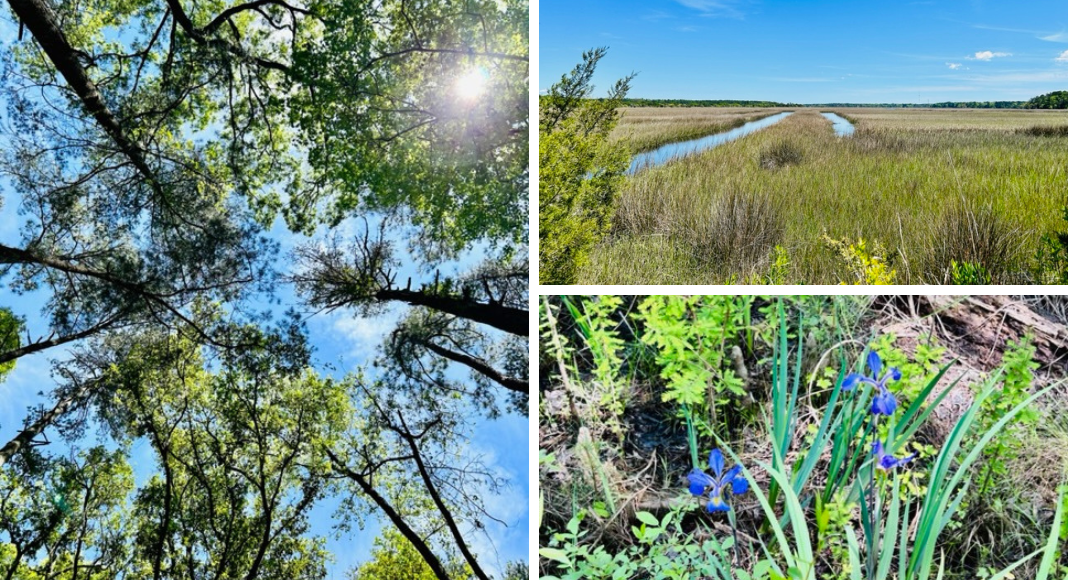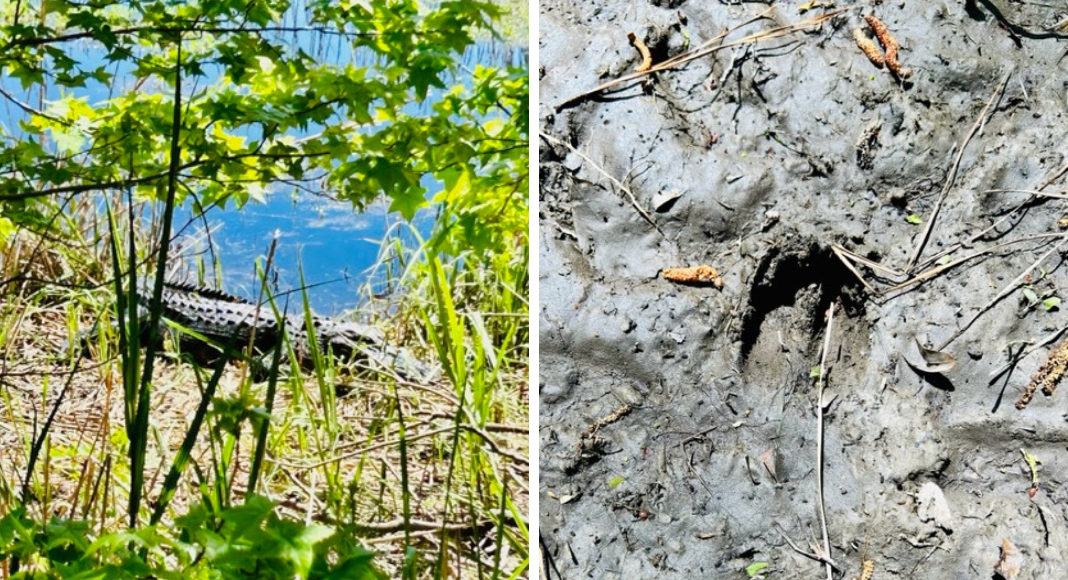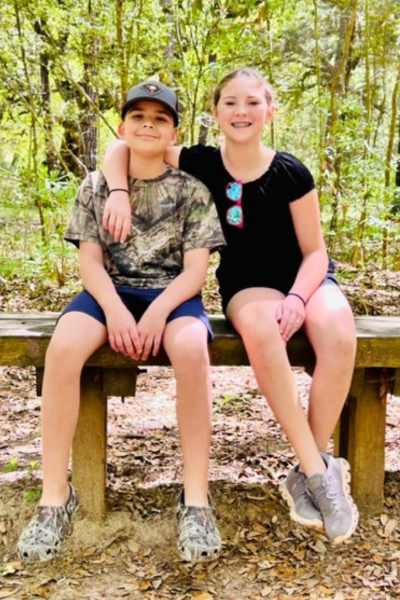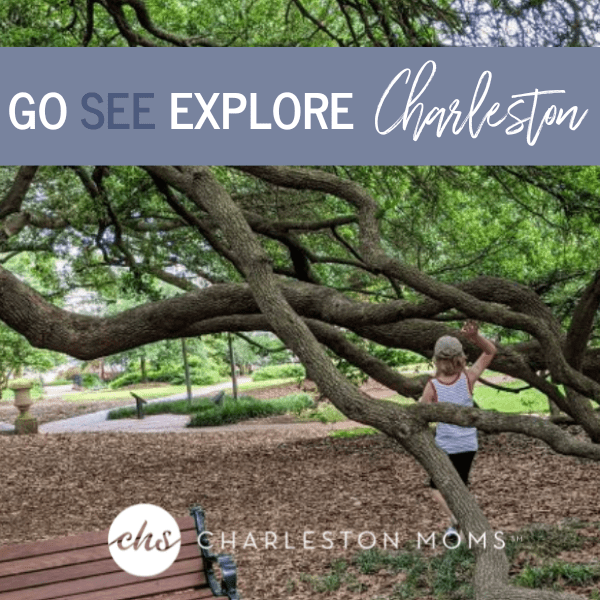We are incredibly fortunate to live in the Lowcountry and call this gorgeous landscape home! There are so many picturesque landscapes here in the Charleston area — beautiful sandy beaches along the vast Atlantic Ocean, salt marsh views that span for miles, healthy forests boasting numerous species of flora and fauna, and even sprawling swamps that are critical to our land’s thriving ecosystem.
Caw Caw Swamp & Interpretive Center
One such swamp, the swamp at Caw Caw Interpretive Center, lies about 25 minutes south of Downtown Charleston in the town of Ravenel. It’s only a short drive down Highway 17, and the park is directly off the highway and really easy to find.
This area of rural, southern Charleston County is where I grew up, and today I am raising my own children in this area. Caw Caw is one of the smaller Charleston County Parks, and it is not as well known as many of the bigger parks in the area. But it is, indeed, an incredible place to visit, and one that you should definitely make the trip to explore.

In the year 2000, the Caw Caw Interpretive Center was opened as part of the network of local Charleston County Parks. Visitors from all over flock to this amazing park to take in the stunning scenery and learn about the area’s history from years past.
Admission is only two dollars per person, and it’s free if you have a county park Gold Pass! The park is open six days a week (closed on Mondays) from 9:00 a.m. to 5:00 p.m.
Caw Caw Interpretive Center is made up of over 600 acres of forests, marshlands, and swamps. There are over six miles of walking trails, which include some areas of elevated boardwalks through the more swampy terrain and wetlands. So put on your walking shoes, get outside, and have fun exploring this incredible habitat right here in Charleston’s backyard!
Wildlife at Caw Caw
The park is considered a “low-impact wildlife preserve,” so bicycles and pets are not permitted in the park.
The center is also considered a “birding hotspot” for this area of South Carolina, as there are over 270 bird species that have been seen on the property, including bald eagles, osprey, painted buntings, and swallow-tailed kites.
During my recent visit with my two kids, a park guide allowed us to use his magnifying scope to view an eagle’s nest high up in the pine trees along the marsh’s edge. He informed us that there were two baby eagles in that nest that were about 12 weeks old and just learning to fly. We learned that bald eagles do not actually develop their white-feathered heads until about four years of age. The baby eagle that we saw that day through the scope was all dark brown in color!
In addition to the numerous bird species, there are many other animals that you may encounter while exploring the park. As you walk the trails, you may see whitetail deer bounding through the forest, or perhaps come across river otters at play in the creeks and marshlands. One of the more popular animals that call this swamp home, the American alligator, is also frequently observed by guests visiting Caw Caw.
Also during our recent visit, I counted more than 10 alligators, of various sizes — some were in the grasses of the marsh, while others were swimming in the canals and creeks. At one point, we observed a mama gator that was roughly seven feet long, and among her were many babies, varying in length from about one foot (last summer’s hatchlings) to three feet long. A park guide informed us that the alligator is the only reptile that stays with its young after the babies are born — the mother alligator protects her young until the babies are about three years old!

As we walked the park’s trails, we also saw many animal tracks in the dirt and mud, including those of deer and raccoons.
We stopped at a bench overlooking a canal and marshland and enjoyed a picnic lunch as we took in the gorgeous views of the sprawling property.
Caw Caw Interpretive Center & Gift Shop
When we returned to the actual Interpretive Center building, we took a walk inside the center, where there is a gift shop complete with souvenirs and educational books related to the swamp and its history.
There were also many displays and exhibits with information about the rice fields that existed on this land over 200 years ago. In the 18th and 19th centuries, the land was made up of many rice plantations that enslaved African people cultivated and farmed.
The visuals in the Interpretive Center helped my children understand exactly how the land was used and how much work went into creating a bountiful rice harvest. In addition to being able to view the swamp’s incredible landscape, we learned a lot about the swamp’s history and its role in the lives of the people who lived in this area before us.
Passing Along Memories at Caw Caw
As a child, I remember my father taking me back into the Caw Caw swamp in our small boat on morning fishing trips, where he told me about its history as mostly rice fields. My dad showed me the old floodgates that were built by enslaved African people. He explained how the dikes and dams worked to irrigate the rice fields, hopefully leading to a bountiful harvest.
I was lucky to have these experiences in the Lowcountry with my father, learning about this interesting swamp before the Interpretive Center was established. And now, I am fortunate to not only live in this extraordinary area of South Carolina, but to also be able to take my kids to this park and explore its beautiful lands and history. I highly encourage you to visit the Caw Caw Interpretive Center as well!
 If you enjoyed this article, then we think you’re going to love the rest of our Go See Explore articles! Check them all out by clicking on the link or the image below!
If you enjoyed this article, then we think you’re going to love the rest of our Go See Explore articles! Check them all out by clicking on the link or the image below!











